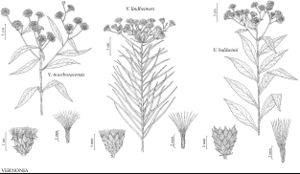Vernonia
Gen. Pl. 2: 541. 1791.
Perennials, 2–20 (–30+) dm (rhizomatous or not). Leaves usually mostly cauline (rarely mostly basal or basal and cauline); sessile or petiolate; blades ovate, elliptic, lanceolate, oblanceolate, spatulate, linear, or filiform, bases usually ± cuneate (rounded-truncate in V. pulchella), margins usually toothed (rarely entire), apices acute to attenuate, abaxial faces usually ± scabrellous to strigillose or tomentose to pannose, sometimes glabrate or glabrous, usually resin-gland-dotted (sometimes ± pitted), adaxial faces ± scabrellous or glabrate, sometimes resin-gland-dotted (rarely pitted). Heads discoid, ± pedunculate, not subtended by foliaceous bracts, (6–) 40–100+ in ± corymbiform to paniculiform arrays (6–) 10–25+ cm diam. Involucres ± campanulate to obconic or hemispheric, 3–8 (–11+) mm diam. Phyllaries 18–70+ in 4–7+ series, the outer ovate to lanceolate or subulate, inner ± lanceolate to oblong, all ± chartaceous, margins entire, often ciliolate, tips rounded (then sometimes apiculate), or acuminate, subulate, or filiform, faces glabrous or sparsely strigillose to tomentose, sometimes ± gland-dotted. Florets 9–30 (–65+); corollas usually purplish or pink (rarely white), tubes longer than funnelform throats, lobes 5, lance-linear, ± equal. Cypselae ± columnar, sometimes arcuate, 8–10-ribbed, glabrous or ± strigillose to hirtellous, often resin-gland-dotted; pappi persistent, of 20–30+ outer, erose to subulate scales or bristles plus 20–40+ inner, longer, subulate to setiform scales or bristles. x = 17.
Distribution
Mainly c, e North America, n Mexico, 2–3 species in South America
Discussion
Species 20 or so (17 in the flora).
The circumscription of Vernonia adopted here follows that of H. Robinson (1999).
Vernonias hybridize; almost every one of the species recognized here has been noted as sometimes hybridizing with one or more others. Putative hybrid plants are usually intermediate between parentals in some traits; such plants may not “key” satisfactorily to any of the species treated here. Some putative hybrids have been named. Vernonia guadalupensis is “without much doubt a hybrid of V. baldwinii Torrey and V. lindheimeri Engelmann & Gray” (L. H. Shinners 1950); V. vulturina Shinners (known only from the type collection) may be a product of V. baldwinii × V. marginata; V. ×georgiana Bartlett may refer to V. acaulis × V. angustifolia. Additional putative hybrids (S. B. Jones 1964) are V. ×concinna Gleason (V. ovalifolia × V. angustifolia), V. ×dissimilis Gleason (V. altissima × V. angustifolia), and V. ×recurva Gleason (V. pulchella × V. angustifolia).
In the key and descriptions, “l/w = ” refers to lengths divided by widths for blades of leaves; lengths of phyllaries include subulate to filiform tips (if any).
Selected References
Lower Taxa
Key
| 1 | Phyllary tips usually subulate to filiform, sometimes acuminate | > 2 |
| 1 | Phyllary tips usually acute to rounded or rounded-apiculate, seldom acuminate | > 7 |
| 2 | Leaves mostly basal (cauline leaves much smaller with narrower blades) | Vernonia acaulis |
| 2 | Leaves mostly cauline (basal leaves wanting at flowering or ± like cauline) | > 3 |
| 3 | Involucres 11–15 mm diam.; phyllaries (50–)60–70+; florets 50–100+ | Vernonia arkansana |
| 3 | Involucres 4–8(–10) mm diam.; phyllaries 22–46(–60+); florets 12–45(–65) | > 4 |
| 4 | Involucres ± campanulate to obconic; florets 12–24(–30+) | > 5 |
| 4 | Involucres ± hemispheric; florets 30–45(–65) | > 6 |
| 5 | Leaf blades (mid stem) lance-linear to filiform, 5–12 cm × 2–4(–8+) mm. | Vernonia angustifolia |
| 5 | Leaf blades (mid stem) oblanceolate to lance-linear, 3–7 cm × (5–)10–20+ mm | Vernonia pulchella |
| 6 | Leaf blade l/w = 2.5–3.5(–4); pappi stramineous to whitish, outer bristles or subulate scales intergrading with inner ones | Vernonia glauca |
| 6 | Leaf blade l/w = (3.3–)4–6+; pappi fuscous to purplish, outer scales contrasting with inner bristles | Vernonia noveboracensis |
| 7 | Phyllaries densely sericeo-tomentose to pannose | > 8 |
| 7 | Phyllaries usually glabrous or puberulent to scabrellous (rarely sparsely arachno-tomentose) | > 9 |
| 8 | Leaf blades adaxially densely sericeo-tomentose; florets 40–50+ | Vernonia larseniae |
| 8 | Leaf blades adaxially usually glabrate, sometimes sparsely arachno-tomentose; florets 12–24+ | Vernonia lindheimeri |
| 9 | Leaf blades abaxially glabrate (and pitted; best seen at 10× or greater, pits containing awl-shaped hairs or glands 0.1–0.5+ mm) | > 10 |
| 9 | Leaf blades abaxially scabrellous, scaberulous, or puberulous to tomentose or pannose (not pitted) | > 13 |
| 10 | Involucres obconic to hemispheric; cypselae 2–3 mm | Vernonia texana |
| 10 | Involucres campanulate; cypselae 3–5 mm | > 11 |
| 11 | Leaf blades 1–3+ mm wide; florets 10–12+ | Vernonia lettermannii |
| 11 | Leaf blades (2.5–)5–20(–40) mm wide; florets (10–)15–25+ | > 12 |
| 12 | Peduncles (3–)10–35 mm; involucres (7–)9–11 mm; phyllary tips ± acuminate; inner pappi 8–9+ mm | Vernonia marginata |
| 12 | Peduncles 1–8(–12+) mm; involucres 5–7(–8+) mm; phyllary tips acute or rounded-apiculate; inner pappi 5–7+ mm | Vernonia fasciculata |
| 13 | Leaf blades 2–8+ mm wide | Vernonia blodgettii |
| 13 | Leaf blades 15–40(–75+) mm wide | > 14 |
| 14 | Stems glabrous | Vernonia flaccidifolia |
| 14 | Stems puberulent to tomentose (sometimes glabrescent) | > 15 |
| 15 | Leaf blades abaxially usually scabrellous (with appressed, awl-shaped hairs), sometimes glabrescent, not or sparsely resin-gland-dotted | Vernonia gigantea |
| 15 | Leaf blades abaxially usually puberulous to tomentose or pannose (with ± erect, ± curled hairs), seldom glabrescent, conspicuously resin-gland-dotted | > 16 |
| 16 | Involucres broadly campanulate to urceolate, (6–)7–10+ × 5–9+ mm; (phyllaries seldom resin-gland-dotted); florets 30–55 | Vernonia missurica |
| 16 | Involucres broadly campanulate to hemispheric, 4–6(–8+) × 4–7+ mm; (phyllaries often resin-gland-dotted); florets (15–)20–25(–35+) | Vernonia baldwinii |
"dm" is not declared as a valid unit of measurement for this property."dm" is not declared as a valid unit of measurement for this property.

